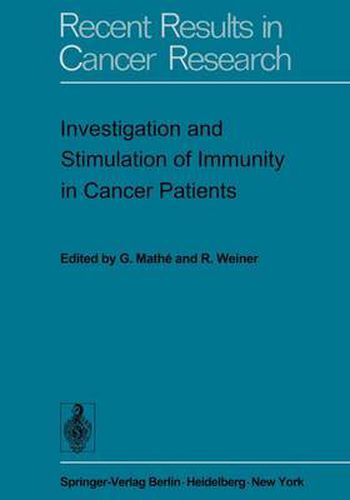Readings Newsletter
Become a Readings Member to make your shopping experience even easier.
Sign in or sign up for free!
You’re not far away from qualifying for FREE standard shipping within Australia
You’ve qualified for FREE standard shipping within Australia
The cart is loading…






This title is printed to order. This book may have been self-published. If so, we cannot guarantee the quality of the content. In the main most books will have gone through the editing process however some may not. We therefore suggest that you be aware of this before ordering this book. If in doubt check either the author or publisher’s details as we are unable to accept any returns unless they are faulty. Please contact us if you have any questions.
G.MATHE Institut de Cancerologie et d'Immunogenetique (INSERM et Association Claude-Bernad), H6pital Paul-Brousse and Institute Gustave-Roussy, Villejuif 20 years ago, the main, if not only object of the cancer therapist was to effect complete surgical exeresis or radiotherapeutic destruction of a local tumor, or to obtain, by means of chemotherapy, an apparently complete regression of a local or disseminated neoplasia. Today it is realized that (a) at the time of the operation or radiotherapy, two patients in every three carrying an apparently localized tumor have a few cancer cells outside the area where the tumor seems localized; (b) when apparently complete regression or even an apparently complete remission is induced by chemotherapy, not all the neoplastic cells have been eradicated. In both cases an imperceptible residual neoplasm persists, the growth of which will in due course make it perceptible again, giving rise to metastasis or to a systemic or localized relapse. There is thus an urgent need for a new technique capable of killing the last cell or cells. Our experiments in mice on the effectiveness of active immunotherapy, which involves the manipulation of the immune machinery, have shown that this treatment is able to kill all the cells, down to the very last cell of a given leukemia, provided that the total number of cells does not exceed a few thousand [1, 2].
$9.00 standard shipping within Australia
FREE standard shipping within Australia for orders over $100.00
Express & International shipping calculated at checkout
This title is printed to order. This book may have been self-published. If so, we cannot guarantee the quality of the content. In the main most books will have gone through the editing process however some may not. We therefore suggest that you be aware of this before ordering this book. If in doubt check either the author or publisher’s details as we are unable to accept any returns unless they are faulty. Please contact us if you have any questions.
G.MATHE Institut de Cancerologie et d'Immunogenetique (INSERM et Association Claude-Bernad), H6pital Paul-Brousse and Institute Gustave-Roussy, Villejuif 20 years ago, the main, if not only object of the cancer therapist was to effect complete surgical exeresis or radiotherapeutic destruction of a local tumor, or to obtain, by means of chemotherapy, an apparently complete regression of a local or disseminated neoplasia. Today it is realized that (a) at the time of the operation or radiotherapy, two patients in every three carrying an apparently localized tumor have a few cancer cells outside the area where the tumor seems localized; (b) when apparently complete regression or even an apparently complete remission is induced by chemotherapy, not all the neoplastic cells have been eradicated. In both cases an imperceptible residual neoplasm persists, the growth of which will in due course make it perceptible again, giving rise to metastasis or to a systemic or localized relapse. There is thus an urgent need for a new technique capable of killing the last cell or cells. Our experiments in mice on the effectiveness of active immunotherapy, which involves the manipulation of the immune machinery, have shown that this treatment is able to kill all the cells, down to the very last cell of a given leukemia, provided that the total number of cells does not exceed a few thousand [1, 2].